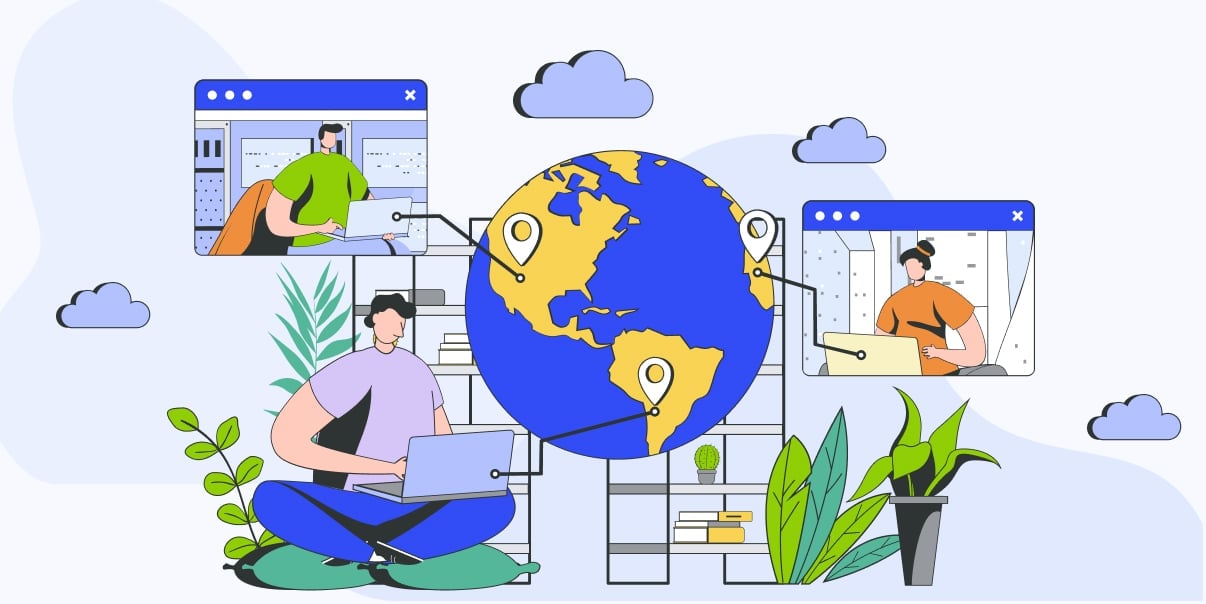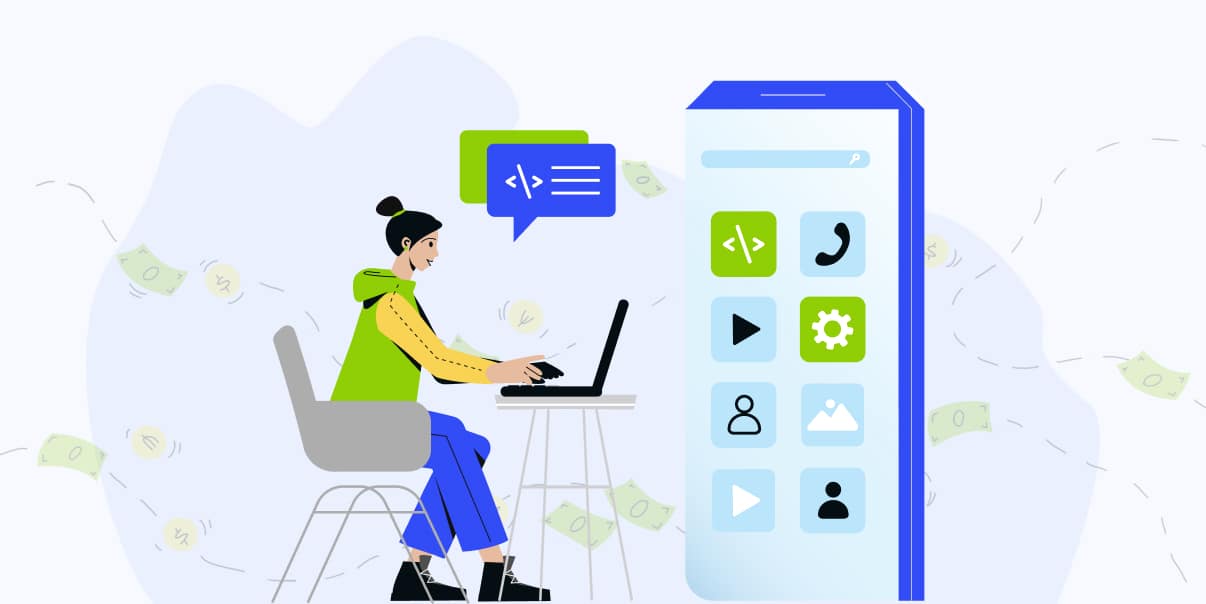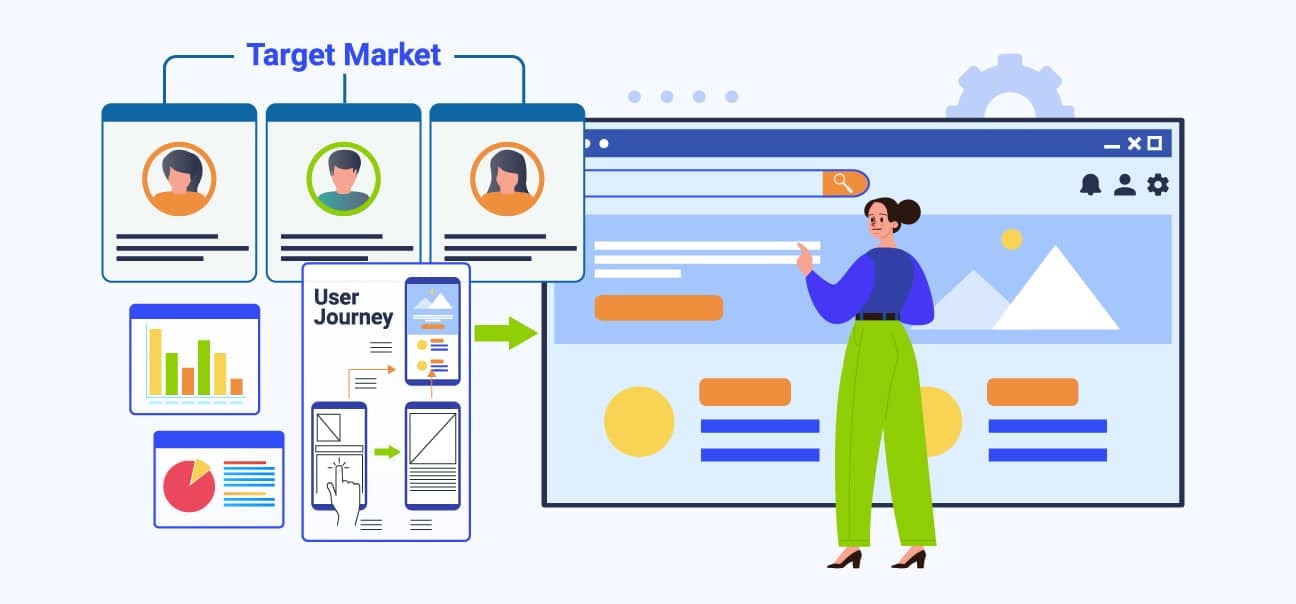Different Types of Software Development — Explained
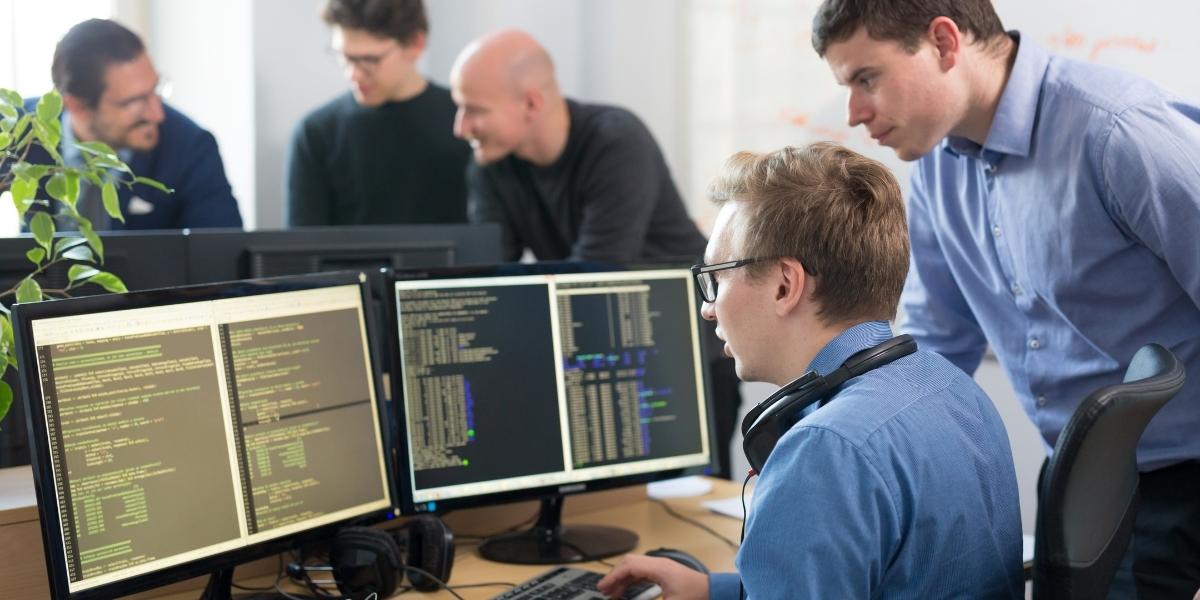
If you’re seeking software developers, you likely have a product or solution in mind. It can be an application, a webpage, or a program to help you carry your idea to reality and plan. The first step is to know the different types of software development.
What Are the Different Types of Software Development?

Several types of software development continue to evolve nowadays. This is due to new approaches, programming languages, platforms, and software development processes.
Here are the 11 different types of software development:
- Web application development
- Mobile application development
- Data science development
- Video game development
- Desktop software development
- Wearables software development
- Cloud computing software development
- DevOps engineering
- Embedded systems development
- Security software development
- Software tools development
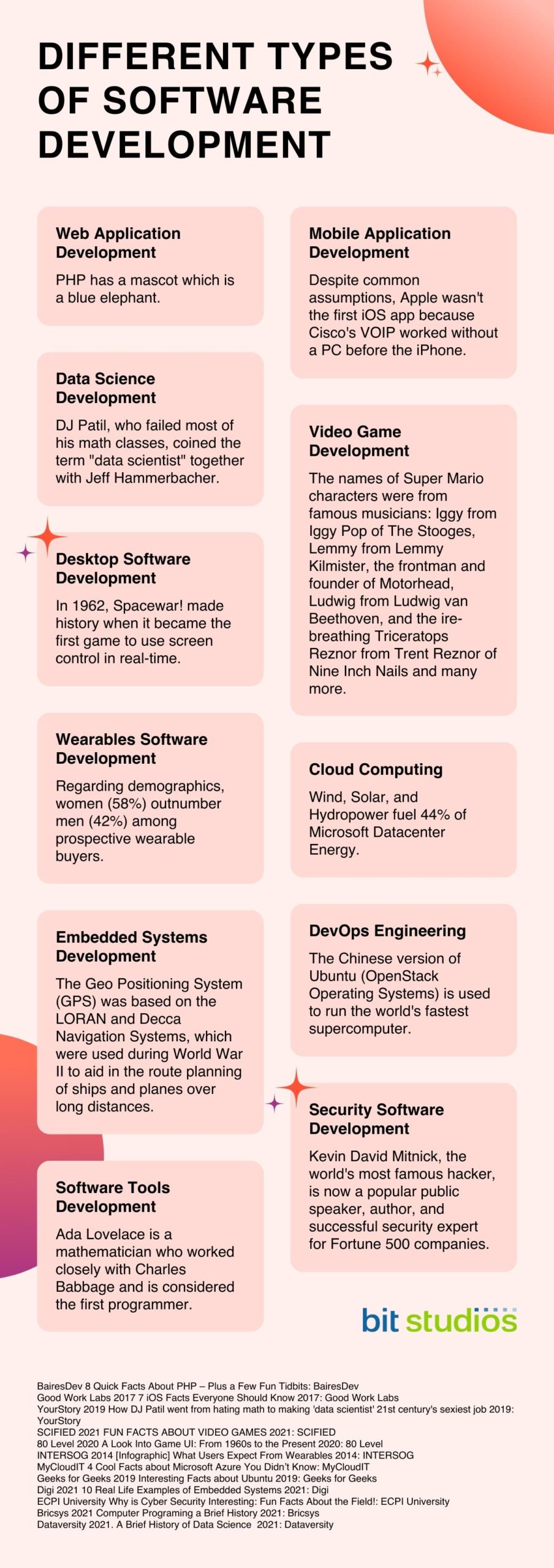

What Is Software Development?
Software Development signifies prearranged and established computer science activities. Its performance is generating, planning, and supporting software. Software development is a set of orders or programs that commands a computer what to do.
Software Development Methodologies
Knowing the different software methodologies in any software development project is important. With a better understanding, you can facilitate your processes. Moreover, you can avoid wasting time and effort.
Waterfall
The waterfall approach is a bit old. But it remains useful today. This method is simple and linear. Before the software development cycle starts, the structure must be clearly defined. Also, all documentation must be ready. It is for this reason that many find this approach too rigid. There’s no room for flexibility. If the development team needs to make changes, it has to start all over again.
Small and not-so-risky projects can take advantage of the waterfall approach.
Agile
Unlike waterfall, agile is more flexible. It pays more attention to satisfying customer requirements. It focuses on collaboration between the developer, customers, and project managers.
Agile is pretty popular among many developers. Use agile if your projects’ needs change constantly.
Scrum
Scrum borrows the flexibility of the agile software methodology framework. Like agile, scrum allows changes in the middle of project development.
Scrum is also an iterative procedure. Projects are broken down into smaller tasks. Each task follows sprints. A sprint is a fixed period of time that developers observe to complete a specific task.
Normally, a sprint lasts for a month. It’s best to use a project management tool to make sure that nothing falls through the cracks.
Lean
Toyota’s manufacturing action is the inspiration behind lean. Its goal is to reduce or totally eliminate wastage. This method also focuses on improving productivity. To do this, the lean method encourages team members to identify potential blockers. The team will then use the insights they gain to tweak the procedure.
Rapid Application Development (RAD)
Needless to say, this is a rapid development process. RAD aims to deliver the project in the shortest amount of time. But it also ensures that the quality of the software developed is not compromised.
Spiral Model
The spiral software development process gives high importance to minimizing risk. It requires heavy planning and risk analysis. This is why this approach is often deemed expensive.
So those were the different software development process models. Now, let’s discuss the various software projects.
Different Types of Software Projects
There are several types of software development projects too. Below are the detailed types of software development. Let’s examine each of these forms of software engineering.
1. Web Application Development

You may access web apps via a mobile device’s browser. You’ll need a browser and an internet connection to use a web app. But, you won’t have to download or update anything. Web apps are dynamic, unlike static websites.
Front-End Web Development
Front-end web development requires creating user interfaces (UI). This is due to the importance of UI in rendering software attractive to end-users.
Required Skills and Tech Stack
- jQuery, CSS, HTML, and JavaScript
- Understands server
- Graphic design skills
Back-End Web Development
A website’s back-end development comprises an application, database, and server. A back-end developer constructs and sustains the technology that powers those elements. Hence, facilitating the user-facing side of the webpage.
Required Skills and Tech Stack
- Python, Java, PHP, SQL, Git, HTML, CSS, JavaScript, CSS, PHP, and HTML
- Data Structures, Algorithms, Databases, and Cache
- Good with servers
- Application Programming Interfaces (APIs) knowledge
- Understands version control and its operating systems
Database Development
Developers use a Database Management System (DBMS) to keep track of the database. Database development creates new databases and integrates existing ones into new applications.
Required Skills and Tech Stack
- Database design and data systems knowledge
- Data management such as permissions, retrieval, safety, and monitoring
- Database entities, such as views, tables, indexes, and statistics
- ETL, BI tools, and SQL
- Troubleshoot new database application issues and provide solutions
- Knows specific programming codes and languages
- Execution procedures for new database
API Development
API development is the process of developing standard procedures and tools. It also involves graphical user interface (GUI) interaction techniques and database access rules. Programmers can use these elements to build API programs. It allows adding new features and capabilities. Web developers build jigsaw puzzle-like programs for desktops, mobile devices, and the web.
Required Skills and Tech Stack
- Knowledge of Java, JavaScript, Node, Python, TortoiseSVN, J2EE, and JUnit. Must also know about PHP, Yii, Symfony2, JSON, XML, REST, Makefile, Apache JMeter, Tomcat7, MySQL
- Develop API connections among many devices
- Cross-platform development
- Front-end development knowledge
- Integration ability
Full-Stack Development
A full-stack developer can work on all aspects of a project. “Full-stack” developers who can code front end and back end are rare. Full-stack developers know many languages, frameworks, and operating systems. Full-stack development saves time and money by offering comprehensive oversight and consistency.
Required Skills and Tech Stack
- JavaScript, Java, Phyton, C#, PHP, Ruby, Perl, CSS, ExpressJS, NodeJS, and HTML
- Write codes to do relational mapping to convey data from databases. This includes SQL Server programming languages, PostgreSQL, MySQL, Oracle Database, and MongoDB
- Version control to handle the project files and track the whole history of the user’s items
- Web hosting platforms
Progressive Web Apps
Progressive web app development is developing websites that mimic mobile apps but have web server hosts. With caching, a PWA works on any device or operating system and requires little storage. PWAs miss some native app capabilities yet load 15x faster.
Required Skills and Tech Stack
- HTML, JQuery, JavaScript, CSS, and web development best practices
- Prototyping, MVP, or POC
- Build responsive structure and design
- App support and maintenance
2. Mobile Application Development

Software development also includes mobile app development. Mobile development produces installable code, binaries, assets, and so on for mobile devices. It also integrates back-end services like data access through an API. Furthermore, testing it on target devices.
Native App Development
“Native” is an app for iOS, Android, Windows, and Symbian. It could also be another OS.
Required Skills and Tech Stack
- C++, JavaScript, Objective C, HTML5, Java, and C#
- Knowledge of software development tools.
- Back-end computing, UI design
- Cybersecurity skills
- Internet of things skills
Cross-Platform Development
Cross-platform mobile apps are cheaper to design but may not support all device APIs or UI demands. No. Performance hiccups are typical. Cross-platform apps allow seamless cross-device and cross-channel interactivity.
Required Skills and Tech Stack
- Flutter, Ionic, React Native, PhoneGap, and Xamarin
- Graphic design skills
- UI/UX skills
- API integration skills
- QA & Testing skills
Hybrid Development
Hybrid development blends native and cross-platform app features. It is also a web app downloaded with a native shell. Native components improve a hybrid app’s user experience. Hybrid apps are easier and faster to design.
Required Skills and Tech Stack
- CSS, HTML5, Angular, Angular 2, and JavaScript or TypeScript
- Mobile web optimization strategies
- Application structuring skills
- Platform-specific design and domain-specific knowledge applicable to the app
- API communication skills
- Data systems and access appropriate to the app
- Syncing data to an online database skills
3. Data Science Development

Data scientists analyze structured and unstructured data sets by using use scientific methods. Data science development includes algorithms and other analytical techniques. Large data volumes can produce knowledge and actionable insights. Data science is the new gold.
AI
Artificial intelligence mimics the human mind’s problem-solving and decision-making abilities. AI is the study and engineering of intelligent machines and computer programs. It’s akin to utilizing computers to investigate human intelligence.
Required Skills and Tech Stack
- Python, Java, C++, and R are the most essential
- Linear algebra, statistics, neural network architectures, libraries, and frameworks knowledge
- Signal processing techniques
Machine Learning
Machine Learning (ML) enables computers to learn without teaching them to do so. ML is one of the most intriguing technologies in recent memory.
Required Skills and Tech Stack
- Python, C++, Java, SQL, Spark, Hadoop, MATLAB, R Programming, Apache Kafka, and TensorFlow
- Weka, IBM Watson Google Cloud ML Engine, Amazon ML, and Pytorch Jupyter Notebook
- Data evaluation and modeling
- Signal processing skills
- ML algorithms and libraries
- Neural network architectures
- Audio, video, and natural language processing
Supervised Learning
Predictive models use supervised learning to pre-define input-output pairings. You can predict new input results with practice data and learning algorithms.
Required Skills and Tech Stack
- Phyton, R, and C/C++
- Microsoft’s CNTK, Google TensorFlow, and Apache Spark’s MLlib
- Programming fundamentals and CS
- Data modeling
- ML libraries & algorithms
Unsupervised Learning
Experts apply unsupervised learning for pattern and structural identification. It begins with a series of data that comprises inputs and aims to uncover a structure in the data units. Afterward, it responds to the existence or absence of such similarities in the data.
Required Skills and Tech Stack
- R, Java, Python, and C++
- Signal processing technique skills
- Neural network architectures
- Audio, video, and language processing
- Immediate prototyping
Deep Learning
Deep learning uses neural networks to enable non-linear data processing and transformation. Deep learning is best for complicated problems.
Required Skills and Tech Stack
- Python, C++, Java, and SQL
- Data structures and computer science fundamentals
- ML mathematics
- Front-end and UI technology
- Cloud computing skills
4. Video Game Development

Video games have been a flourishing industry since their beginnings. Moreover, creators use technologies like Unity and C#. Video games are interactive software for computers and consoles. Recently, it also integrated mobile devices where visual feedback is essential.
Lumberyard
Lumberyard by Amazon, an e-commerce company, is a free and ready cross-platform engine. It focuses on CryEngine, which has been in beta since 2018.
Required Skills and Tech Stack
- Lua, C, C++, and Script Canvas
- Cloud Canvas
- Cloud Gems Framework
- Cloud Gem Portal
Unreal
C++ builds Unreal and is available for free distribution. This includes commercial usage supported via a licensing mechanism. Prominent games, including Fortnite, have made use of Unreal.
Required Skills and Tech Stack
- C++, HTML5, and jQuery
- Google Analytics
- 3D computer graphics game engine
Unity
Unity Technologies created a complete game engine of around 200. It handles 2D, 3D, and VR games for Windows, Mac OS, consoles, and internet platforms.
Required Skills and Tech Stack
- Unity software platform, including scripting, textures, animation, GUI design, and user session management
- C, C++, and C# programming languages skills
- Level design and planning
- Game physics and particle system
5. Desktop Software Development

Desktop development creates software that you can use on personal computer operating systems. This includes Windows, Mac OS, or the classification of Linux.
Windows Development
C# integration to create Microsoft Windows system programs, frameworks, or applications.
Required Skills and Tech Stack
- C#
- WPF
- ElectronJs
- UWP
- Xcode
- Python
- Ruby
- Perl
- Red
- Object Pascal
Mac OS Development
The macOS only operates on Apple units. Thus, you must have a Mac to create and execute macOS applications.
Required Skills and Tech Stack
- Electron Js
- Cocoa
- PyObjC
- RubyCocoa
- PasCocoa
- Red
- Object Pascal
Linux Development
Linux desktop market rate ranges from around 1.74% to 2.18%. Thus, developing Linux with market share is unusual. But since Android builds on the Linux kernel, its success drives progress in the Linux computer market.
Required Skills and Tech Stack
- Red Hat Linux/ Unix system expertise
- OS troubleshooting, configuration, backup, security, disaster recovery, and performance monitoring responsibilities
- RHEL 6.x/7.x, Red Hat Cluster, and scripting
- Bourne shell, Csh, Ksh, Bash Shell, and Python expertise are necessary
6. Wearables Software Development

Wearables or wearable technology refers to software equipment that you can wear. The wearables business is booming, with a 22.5% compound annual growth rate. It is now spreading into wristwear, headgear, jewels, footwear, and even fabrics. The most typical are:
Watches
Wearable wrist innovation no longer restricts only fitness monitoring or digital wallets. Nowadays, watches have features for social networking, fitness monitoring, work, and even gaming.
Required Skills and Tech Stack
- JavaScript
- Native C
- Tizen
- Web app and other APM technologies
Glasses
Smart wearable glasses provide a wide range of features. It has a simple Bluetooth sound connectivity. It also incorporates cameras and a combo of virtual reality (VR) and artificial reality (AR).
Required Skills and Tech Stack
- AR Development
- PostgreSQL
- MySQL
- DataDog
- NewRelics and other APM technologies
7. Cloud Computing Software Development

Cloud computing services transport data from local storage to remote servers. This is best for storing and processing. Cloud computing software development includes developing a type of software. It powers cloud storage applications like DropBox, Amazon Web Services, IDrive, or OneDrive.
Serverless Computing
Serverless computing delivers back-end services when required. It also eliminates the obligation to spend on a certain number of services or bandwidth.
Required Skills and Tech Stack
- Phyton, Java, and JavaScript skills
- SQL, NoSQL, and Apache Kafka
- Service platform expertise
- Build API
- Database and network management skills
- DevOps, ML, and AI skills
8. DevOps Engineering

DevOps emphasizes rapid, efficient, and customer-focused software delivery. DevOps engineers work with DevOps-adhering groups. From conception to deployment, it involves all product lifecycle phases. It also includes QA testing.
Continuous Integration (CI)
Agile often produces, tests, and merges new user stories into the old system. This ensures the integrity of the software.
Required Skills and Tech Stack
- Optimizing and automating processes skills
- Develop CI principles, maintain CI tools, and platforms
- Can handle infrastructure assets such as servers, networks, DBs, and OS
- .deb, .exe, .rpm, and Docker
- Version control tools such as Subversion, Git, and Mercurial
- Manage cloud providers like Azure, AWS, and GCP
Continuous Deployment (CD)
Continuous deployment means changes in the code are automatically deployed to production.
Required Skills and Tech Stack
- Same with Continuous Deployment
9. Embedded Systems Development

Embedded systems development are mechanically-integrated systems. New engines, mobile gadgets, and manufacturing equipment use embedded systems development.
Required Skills and Tech Stack for Embedded Systems
- C, C++, and Python
- Microcontrollers, microprocessors, and device drivers
- Software optimizations and real-time operating systems skills
- Debugging skills
- Schematic reading skills
- Internet of Things (IoT)
- Data structures understanding skills
- RISC-V instruction set architecture
- Work with existing codebases
- Interrupt-driven design
- Assembly programming language
10. Security Software Development
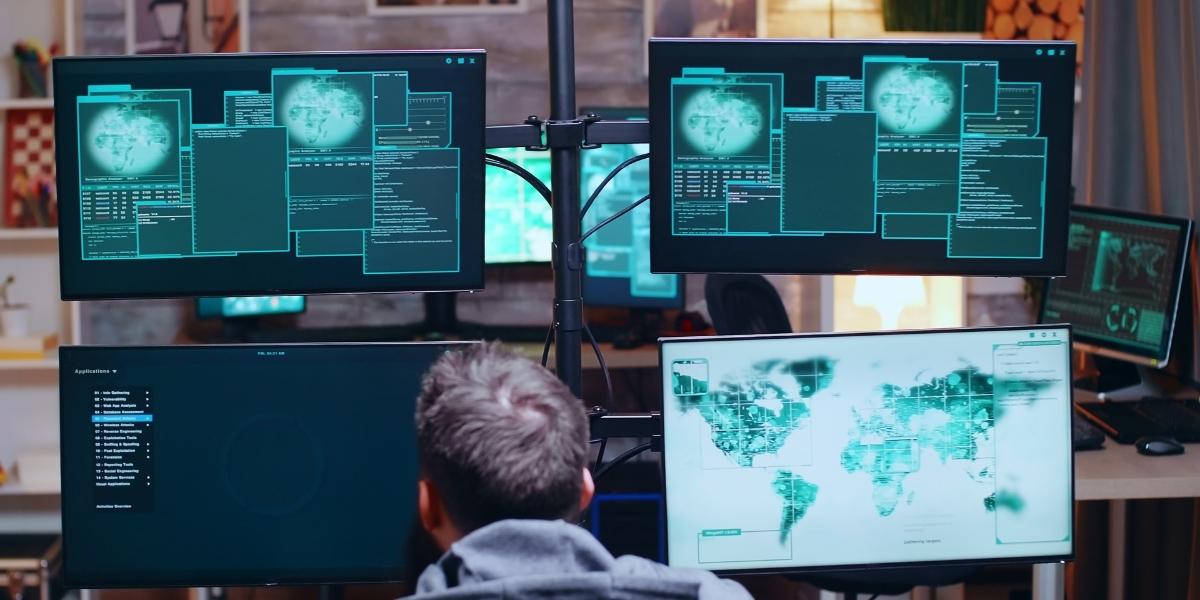
Anti-virus, intrusion indicators, and firewall software protect networks and devices from cyberattacks. Responsible cybersecurity experts work here to protect company networks and data.
Required Skills and Tech Stack
- Data structures, algorithms, source code programming languages, security hardware, software, and solutions
- Black-box and white-box testing and unit testing
- Knows cybersecurity and hacker techniques
- Work in a fast-paced setting
11. Software Tools Development

Most programmers use software tools to construct and test apps. Aside from helping developers save time and effort. Software tools also contribute to standardizing software development practices.
Required Skills and Tech Stack
- Testing basics
- Developers languages
- Source control
- Operating system
- Networking basics
- Data algorithms and structures
- Software development life cycle (SDLC)
- Integrated development environment (IDEs)
- Databases
- Cryptography and encryption
To build your firm, it is necessary to have these software developments. Before beginning a company, you must research how the industry works.
Ready to build your custom software application? Request free software development consultation. Discover how your company can enjoy BIT Studios‘ custom software application development. Explore mobile application development, company analysis solutions, and web app design services. BIT Studios has assisted micro, mid-range, and big businesses.
Feel free to contact us at any time.
Frequently Asked Questions
What Is Software Development?
Software development plans, develops, tests, and presents a software product. It also shows the complete process of development.
What Is Application Development?
Application development creates a computer program or a combination of computer programs. It works on a specific task that supports business goals.
Why Is Software Development Important?
Successful businesses develop software that aids in customer solutions. This is because software development improves user experiences and simplifies day-to-day operations. Software development creates individualized digital experiences.
Why Choose BIT Studios for Your Software Development Needs?
You can combine many processes with BIT Studios’ custom software development services. You can have the ones managed by various platforms into a single large-scale program. We leverage different types of software development processes to develop custom solutions. It also increases the capabilities of existing tools. Furthermore, it integrates them with current systems. We also have a dedicated project manager. Our project manager will assist you in the software development process.
What Factors Should You Consider in the Software Development Life Cycle?
Here are factors you need to consider during the software development process.
One of these is the scope of your project. You need to know how big or small it is for you to plan effectively. Building a software program isn’t simple. The development process may take a wrong turn if you’re not prepared.
You also need to consider the software development methodology framework. Are you going to go for agile software development? Or does scrum works better?
The budget also plays an important role. Your financial resources will dictate the overall approach of your software projects.
We’re BIT Studios!
At BIT Studios we specialize in designing, building, shipping, and scaling beautiful, usable products with blazing-fast efficiency

